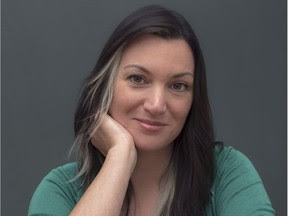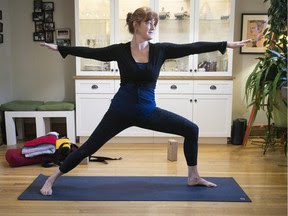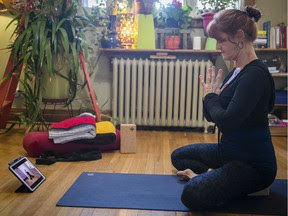In meditation, “there is this idea of acceptance and of letting go, of stilling the mind.”
Montrealer Anne Royer has been practising yoga for years and finds in her discipline “internal peace and a fresh outlook on the day.”
When the COVID-19 pandemic took hold, the retired nurse decided to increase her practice to a daily one. “Regular yoga became very important during COVID time,” she said. “I was doing it as a preventive measure; I knew that if I wasn’t doing yoga, things would be much worse.
“Yoga is very good for me and very grounding. It is good for my body, but my spirit and my mood are always better because I have done yoga.”
Royer, 59, is among the many Canadians who have incorporated yoga, meditation or some other mindfulness practice into their daily lives during the pandemic. Call it self-care: they say the practice makes them feel less anxious and more in control during a time when anxiety rules and control is elusive.
Yoga is a mind and body practice with roots in ancient Indian philosophy. Various styles combine physical postures and positions, breathing techniques and meditation or relaxation. Holding yoga poses “allows you to be in the moment and, if you are in the moment and your mind is not racing to anything, you are in a meditative state,” Royer said.
She can meditate during yoga practice, but also while she is out walking. “I find that with meditation and yoga, I have another layer of peace around me, of serenity, of quiet,” she said.

Yoga, meditation and mindfulness teacher Lisa Sabatini says the COVID-19 pandemic has changed what her students are seeking from classes. Courtesy of Lisa Sabatini
Lisa Sabatini, an Ottawa-based teacher of yoga, meditation and mindfulness who also does healing work, said the pandemic has changed what her students are seeking from classes. “For yoga, I am finding people are coming for stress relief, not necessarily the healthy exercise that yoga is. Same with meditation and mindfulness.”
The pandemic means that “everything is a stress trigger because everything is so chaotic and unfamiliar,” she said. “Meditation and mindfulness can help with that.”
These days, Sabatini gives classes mostly live over Zoom or in pre-recorded sessions — and class composition has also changed. More men have signed up, for one, and the age range has broadened to include older and younger people.
Part of her job as a yoga instructor is “to hold space” for people to have the quiet time needed for their practice.
“People don’t realize they have been holding their breath all day. So the first thing we do is connect with the breath, slow it down — and check in with what is going on inside of us,” she said.
“We are so overstimulated with what is going on outside that we don’t realize what is going on inside. Paying attention to it, rather than ignoring it, is how we effect change.”
The class prepares people to apply what they’re learning, “so that when something happens that stresses us out, we are able to respond rather than react,” Sabatini said. “We recognize, ‘OK, I am overwhelmed in this moment and I would like to choose a response.’ And that changes the outcomes, in terms of our relationship with people and ourselves.”
The skills she teaches are portable. “We can practise mindfulness when we are brushing our teeth, washing dishes — we can apply it any time,” she said.

For Montrealer Anne Royer, yoga and meditation comprise one form of self-care — as do daily walks and outdoor skating. PHOTO BY PIERRE OBENDRAUF /Montreal Gazette
For Royer, yoga and meditation comprise one form of self-care — but daily walks and, in winter, outdoor skating are also “key to my well-being,” she said. She takes ballet and jazz dance and courses on topics ranging from music theory to ukulele — all, for the time being, over Zoom.
“Adding dance and music to my life is good for my mind, body and soul, at all times — and especially in these difficult and strange times.”
One day a week, she takes a yoga class taught by Andrea Shepherd of MonTango, a Notre-Dame-de-Grâce tango studio where Royer and her husband normally take dance classes.
(Guidelines vary depending on province and region, but in Montreal and other red zones in Quebec, indoor fitness facilities including gyms and dance studios reopened March 26, with certain restrictions. They were ordered to close again as of April 8, although some private instruction is still permitted.)
Shepherd has been practising yoga for a decade and teaching it since 2017. When the pandemic began, she resolved to practise daily.
“I see yoga as something very therapeutic,” she said. “You are building your strength; it helps with balance and awareness of posture; it keeps your bones stronger, your joints more lubricated and your lungs working better. And taking the time for yourself is really beneficial.
“In yoga, everything you do is about repeating techniques to better live your life — whether standing on one foot to have better balance or learning to let go and even accepting the negative thoughts you’re having.”
In meditation, “there is this idea of acceptance and of letting go, of stilling the mind,” Shepherd said. “If my mind wanders as I am doing yoga and I want to bring myself back to stillness by focusing on the breaths or not getting frustrated that my mind wandered, then it’s a practice.”
Shepherd teaches two yoga classes a week at MonTango, takes a weekly class with yoga teacher Josephine Vittoria and has continued her own yoga teacher training — all of it online.
In non-pandemic times, Montrealer Eva Stelzer organizes custom luxury travel and hosts group travel holidays focusing on activities including dance or hiking. With that scene quiet, “I needed something for me,” she said. Last summer, she signed up for a weekly yoga class with Shepherd.
Quickly, the class “became the highlight of my week,” she said.
She had practised yoga before, but Shepherd’s class “has gotten me more into yoga. Andrea’s style is methodical, it involves deep stretching and it is very suited for my needs,” said Stelzer, a ballroom dancer.
Shepherd’s style involves taking the time to complete a stretch and hold a position.
“One of the things we don’t have in our lifestyle is patience. COVID has forced a slowdown — and yoga has taught me patience,” Stelzer said. “The way to get the job done here is not to rush. To learn that is a revelation for me.”
Nirvair Kaur Chawla credits yoga for helping her recover from thyroid cancer without pain medication. But as she got busy with school and work, there was less time for yoga.
She began a yoga teacher-training program online in July.
“It helped a lot to connect with others virtually and to deepen my own yoga and mindfulness practice,” said Chawla, 30.
“I feel like yoga gives me some calm. Whenever I do yoga, I manage to create a pause.”
She focuses on a style of yoga “that is all about slowing down and opening your body through passive stretching, a restful practice” and has been teaching yoga online to family members in Canada, the United States and the United Kingdom.
“Many are seniors and it has helped to bring them connection and movement,” said Chawla, who is enrolled in a graduate program in health-care management at Université Laval and works at a Montreal health authority as part of Quebec’s COVID-19 vaccination campaign.
She has also started to teach yoga to friends and acquaintances virtually and launched a YouTube channel.
The practice of yoga “has really helped my mental health throughout COVID — and the feeling that I am helping others helps me.”



Comment here